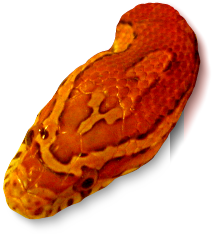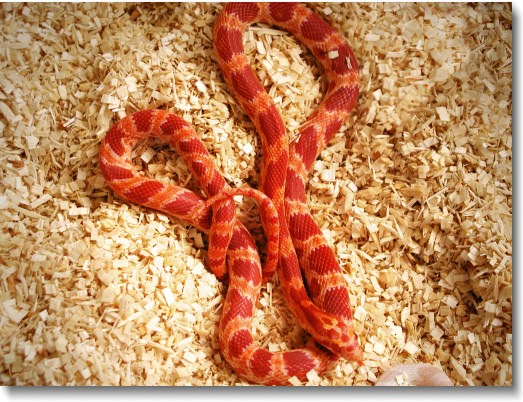Corn Snake
pictures and facts

The Enclosure
The size of enclosure an adult corn snake needs is at minimum a standard 20 gallon aquarium tank, 30" long x 13" high x 12" wide. [55] However depending on the size and number of other items in the enclosure (water dish, hid boxes, branches and other natural props) you may need more room. The rule of thumb is that at least 30 to 40% of the floor space should be left open, and the snake should be able to stretch out long enough to allow their lungs to extend to full length. There must be sufficient space to set up a temperature gradient, so the snake can thermoregulate, drink, bask, sleep, and feed. [56] Another thing to consider is the lid. Corn snakes are very well known for their ability to fit through anywhere their head can fit, or simply push their way out of an enclosure. Make sure you get a lid that fits securely. One of the most common experiences with new corn snake owners is having them escape! [57]Substrate
Substrate is the material on the bottom of the enclosure. Some common substrates include reptile bark, butcher paper, paper towels, and Astroturf. Note: cedar shavings cause respiratory problems in snakes and should not be used. Pine shavings have been used by some successfully, but others do not like them because of the same concerns as cedar. Corn cob bedding (made for birds) should not be used, as it causes excessive drying of dermal tissues, and if swallowed can cause serious intestinal blockages. While reptile bark creates a very natural look, butcher paper or paper towels are cheap enough to simply discard, and replace with new material. If you use Astroturf cut 2 piece that fit the enclosure. When you take one piece out to clean it you can put the other piece in, as the first piece will need to dry overnight. [58]
An amelanistic corn snake.
Image Source: Photo taken by Corn Snake Pictures & Facts at the San Bernardino County Museum, with permission.
Available in two sizes:
1024 x 768 || 800 x 600
Heating
Like all reptiles, corn snakes rely upon the ambient temperature in their environment to regulate their body temperature. If they are too cold they must find a warmer place within the enclosure in order to raise their body temperature. The same is true in reverse. For them to lower their body temperature they must find a cooler spot. This is why a temperature gradient within the enclosure is so important. One end of the enclosure should be warm (80 to 85°F [26.7 to 29°C]), and the other end at close to room temperature. This will allow your corn snake to select the area that is most comfortable for it. Warmth in particular is critical for the health of your snake. Heat is required for proper digestion and the effective functioning of the immune system. [59] But it must be delivered in a way that does not burn the snake. This is harder than it may seem because the snake cannot be relied upon to avoid hot surfaces, as they have a lack of feeling on their scales. Some tank heater pads which do not have rheostats or thermostats to control them can reach 130°F (54°C) which will burn the snake. [60] There are three usual ways of creating a heat gradient in the enclosure. 1. An incandescent lamp can be used if you're lid is made of screen. 2. An under the tank heater, which is a plastic pad with adhesive on one side. The pad is attached to the underside of the tank on the side you wish to warm. As noted earlier make sure the pad has some kind of temperature control. A thermostat is best. 3. The third is a hot rock, however this is not usually recommended because the heat is too concentrated. This not only can potentially burn the snake if it is too hot, but also does not distribute the heat over a large enough area for the snake to be warmed evenly all over. However if a heat rock must be used, either bury it in substrate, or use a newer models that has a thermostat. Regardless of which method you use, the goal is to produce a warm area 80 to 85°F (26.7 to 29°C), large enough for the snake to rest in, on one side of the enclosure, and a close to room temperature area on the other side. [61]